New Jersey Butterfly Club
A chapter of the North American Butterfly Association (NABA)
Troy Meadows Wetlands
p>by Mike NewlonCounty: Morris.
Municipalities: East Hanover, Hanover, and Parsippany-Troy Hills.
Directions: From I-80, take exit 45 (signed Lake Hiawatha/Whippany; about 1 mile east of the I-287 interchange), and turn south on South Beverwyck Road (County Road 637).
Parking: Yes. Troy Meadows Road and Alan Road have parking for a small number of cars. Cameron Dog Park and Patriot's Path parking areas are somewhat larger.
Nearest sizable town: Parsippany, reached by going north on South Beverwick Road (becomes North Beverwyck after crossing over I-80). Immediately after the overpass one can turn left into a large shopping center. Or you can continue and turn left or right on Rte 46 where there are innumerable stores. (Rte 46 is divided so you will have to continue some distance before being able to return.)
Habitats: Swamp forest, marsh, clearings.
Maintained/Marked trails: Yes. Off Troy Meadows Road, along the gas-line cut, in the deer exclosure reached from Alan Drive, and at the Patriot’s Path Section.
Restrooms: No.
Picnic tables: No.
Species recorded: E Tiger, Spicebush, and Black (scarce) Swallowtails, Cabbage White, Clouded and Orange Sulfurs, Eastern Tailed-Blue, Summer Azure, Hickory (scarce), Banded, Striped, and Gray Hairstreaks, Variegated and Great Spangled Fritillaries, Pearl Crescent, Baltimore Checkerspot (once), Eastern Comma, Question Mark, Painted and American Ladies, Common Buckeye, Red Admiral, Red-spotted Purple, Viceroy, Monarch, Little Wood Satyr, Appalachian Brown, Common Wood-Nymph, Silver-spotted Skipper, Northern Cloudywing (scarce), Wild Indigo and Horace’s Duskywings, Least, European, and Swarthy Skippers, Little Glassywing, Northern Broken-Dash, Hobomok and Zabulon Skippers, Black Dash, Mulberry Wing, Delaware, Dion, and Dun Skippers.
Best time to visit: For butterflies, summer. Good all year for birds.
Exploring Troy Meadows Wetlands: Troy Meadows, like the Great Swamp, is a remnant of Glacial Lake Passaic. It is a well-known birding spot, covered in William J. Boyle, Jr.’s A Guide to Bird Finding in New Jersey, pp. 132-136. Most remaining wild land is owned by the private non-profit conservation organization Wildlife Preserves, and some by the State of New Jersey. Once the largest freshwater marsh in the state, it has been substantially degraded by highway construction, residential and industrial development, deer browsing, and invasion by non-native plants, notably Common Reed, Barberry, and Japanese Stiltgrass. However much natural habitat remains. Recently Wildlife Preserves has initiated measures to eradicate invasive non-native plants and promote recovery from deer damage.
Four regions of Troy Meadows are of interest to butterfliers, described below in the order in which I usually cover them:
Troy Meadows Road: Drive south on South Beverwyck about 0.7 mile and turn left on Troy Meadows Road. Continue through the suburban neighborhood into the woods until you reach a gas-line cut and a fenced enclosure on the right, and park here. Past this point, Troy Meadows Road is poorly maintained, often wet, and sometimes under water. Consider road conditions, and your vehicle’s capabilities, before attempting to drive farther. Often it is best to walk from here. Walk down the gas-line cut to the left until you reach Troy Brook. This area has produced Dion Skippers; the best time seems to be before 9AM. Return the way you came and continue down Troy Meadows Road, keeping an eye out for Anglewings and Red Admirals in the road; Little Wood Satyrs and Appalachian Browns can be common here in mid-summer. Just past the metal bridge (over West Brook), a gated-off track on the right leads through forest and clearings and ends at the gas-line cut. One can walk up and down the cut but going gets difficult and it is usually easiest to return to the road the way you came. Continue down Troy Meadows Road to a large open area at the end, once used as a skeet-shoot range. Look for stands of blooming Dogbane and other flowers.
Alan Drive: Return to South Beverwyck, turn right, drive about 0.3 miles north, then turn right into Alan Drive; continue to its end and park at the turn-around. Walk straight ahead down the obvious track from the turn-around to reach the gas-line cut. Here you have two options, both worth taking: (1) turn right and walk down the cut until you reach Troy Brook, then return the way you came. (2) turn left and walk down the cut until the track ends at the marsh edge. In summer, blooming dogbane and milkweed are attractive to hairstreaks, including the occasional Hickory. A few hundred feet past your starting point, a side track on the right leads to a gate in the high deer-exclosure fence and continues, mostly through forest, to the marsh edge. If you enter, please close the gate behind you.
Cameron Dog Park: Return to South Beverwyck and drive about 0.2 mile north, turn right into the Dog Park, and continue to the parking area at the end of the entrance road. Check the edges of the large clearing here. At the SE corner of the clearing, an unmarked, un-mowed, and rutted track leads through woods to another clearing, where Delaware Skippers have been found. Little Wood-Satyrs can be abundant at the edge and interior of the surrounding woods. One can bushwhack through the woods at the back of the clearing to reach the gas-line cut but this is far more easily reached from Alan Drive.
Patriot’s Path: Return to South Beverwyck, turn left and drive south. In about 0.8 mile stay left at the fork to stay on South Beverwyck; continue about 1.2 miles to an un-signed parking lot on the left. Walk east on the mowed Patriot’s Path. In about 0.15 mile this trail bears right; in about 0.4 mile the trail forks. The right fork takes you to after another 0.2 mile to Troy Road; the left fork, after about 0.7 mile also ends at Troy Road. A field across Troy Road here may be worth checking if you still have the energy. You can return to your car the way you came or walk back on Troy Road to South Beverwyck.
Special precautions: Much of Troy Meadows is swamp or marsh, so rubber boots may be convenient or even necessary. In mid-summer the area can be very hot and humid, and biting insects may be all-too-abundant. Getting off-road/trail requires precautions against ticks.
To view a larger map, click on 'View larger map' icon in upper right hand corner. (Tip: The satellite view may also suggest good potential butterfly habitat to explore.)
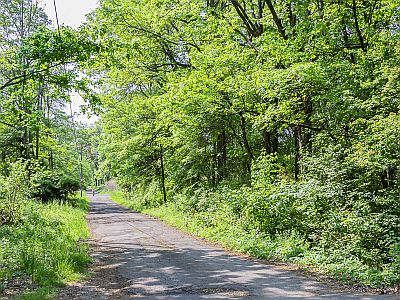
Troy Meadows Road.
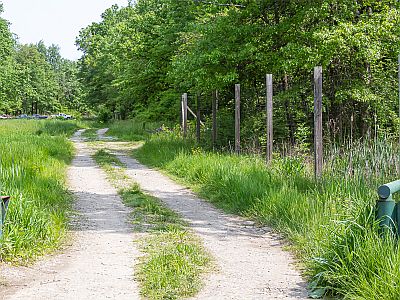
Troy Meadows Rd. Gas Line Cut.

Alan Drive Entrance Track.
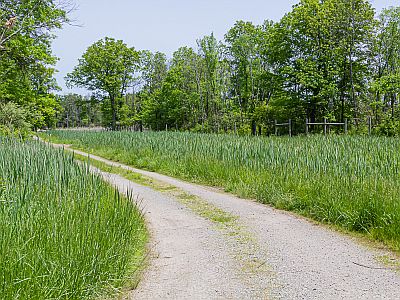
Alan Drive Gas Line Cut.
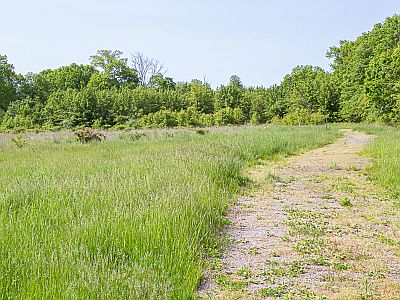
Cameron Dog Park.
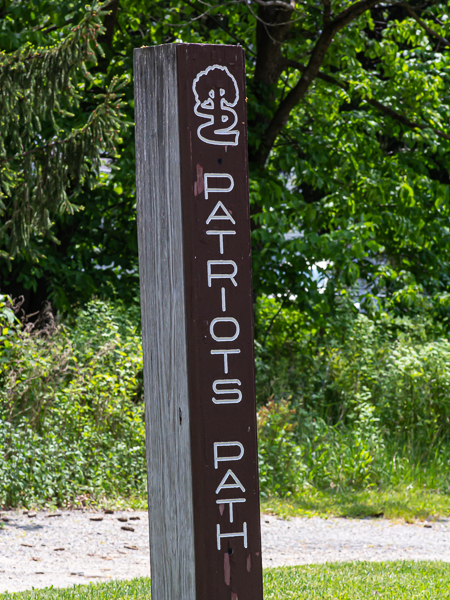
Patriot's Path Sign.
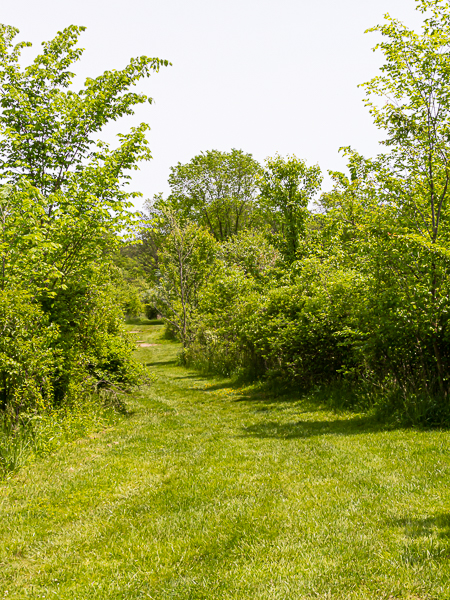
Patriot's Path.